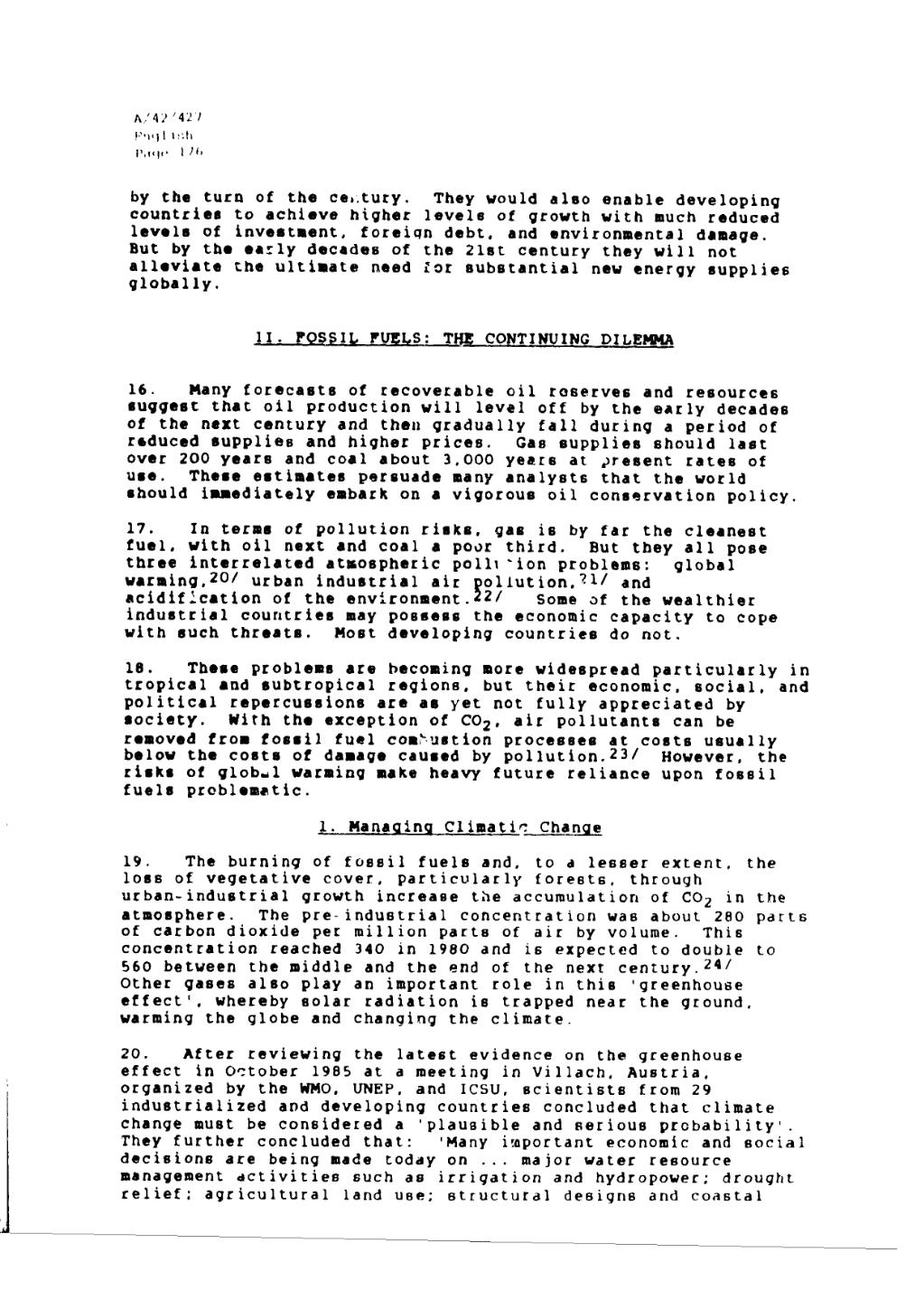A/42/427
English
Page 176
by the turn of the century. They would also enable developing countries to achieve higher levels of growth with much reduced levels of investment, foreign debt, and environmental damage. But by the early decades of the 21st century they will not alleviate the ultimate need or substantial new energy supplies globally.
Ⅱ. FOSSIL FUELS: THE CONTINUING DILEMMA
16. Many forecasts of recoverable oil reserves and resources suggest that oil production will level off by the early decades of the next century and then gradually fall during a period of reduced supplies and higher prices. Gas supplies should last over 200 years and coal about 3,000 years at present rates of use. These estimates persuade many analysts that the world should imediately embark on a vigorous oil conservation policy.
17. In terms of pollution risks, gas is by far the cleanest fuel, with oil next and coal a poor third. But they all pose three interrelated atospheric pollution problems: global warming,[1] urban industial air liution,[2] and acidification of the environment.[3] Some of the wealthier industrial countries may possess the economic capacity to cope with such threats. Most developing countries do not.
18. These problems are becoming more widespread particularly in tropical and subtropical regions, but their economic, social, and political repercussions are as yet not fully appreciated by society. Wih the exception of CO2, air pollutants can be removed from fossil fuel comustion processes at costs usually below the costs of damage caused by pollution.[4] However, the risks of global warming make heavy future reliance upon fossil fuels problematic.
1. Managing Climatic Change
19. The burning of fossil fuels and, to a lesser extent, the loss of vegetative cover, particularly forests, through urban-industrial growth increase the accumulation of CO2 in the atmosphere. The pre-industrial concentration was about 280 parts of carbon dioxide per million parts of air by volume. This concentration reached 340 in 1980 and is expected to double to 560 between the middle and the end of the next century.[5] Other gases also play an important role in this 'greenhouse effect', whereby solar radiation is trapped near the ground, warming the globe and changing the climate.
20. After reviewing the latest evidence on the greenhouse effect in October 1985 at a meeting in Villach, Austria, organized by the WMO, UNEP, and ICSU, scientists from 29 industrialized and developing countries concluded that climate change must be considered a 'plausible and serious probability'. They further concluded that: 'Many important economic and social decisions are being made today on … major water resource management activities such as irrigation and hydropower; drought relief; agricultural land use; structural designs and coastal
- ↑ WMO, Report of International Conference, op. cit.; I. Mintzer, 'Societal Responses to Global warming', submitted to WCED Public Hearings, Oslo, 1985; F.K. Hare, 'The Relevance of Climate', submitted to WCED Public Hearings, Ottawa, 1986.
- ↑ Lohani, op. cit.; Weidner, op. cit.; Hashimoto, op. cit.; CETESB, op.cit.
- ↑ Torrens, op. cit.; F. Lixun and D. Zhao, 'Acid ain in China' prepared for WCED, 1985; H. Rodhe, 'Acidification in Tropical Countries', prepared for WCED, 1985; G.T. Goodman, 'Acidification of the Environment, A Policy Ideas Paper', prepared for WCED, 1986.
- ↑ Torrens, op. cit.
- ↑ Bolin et al., op. cit.
